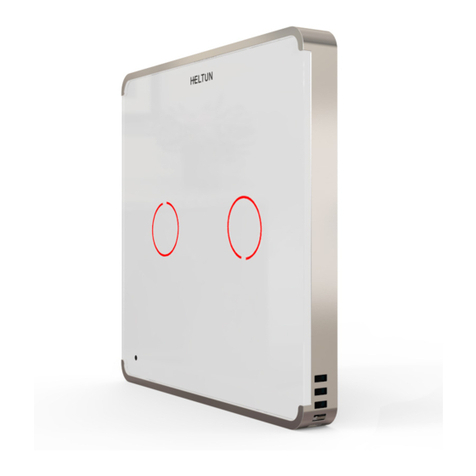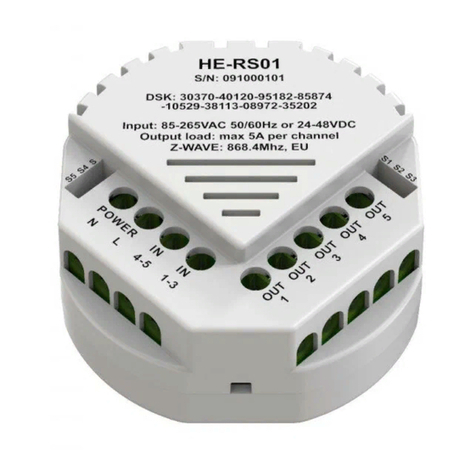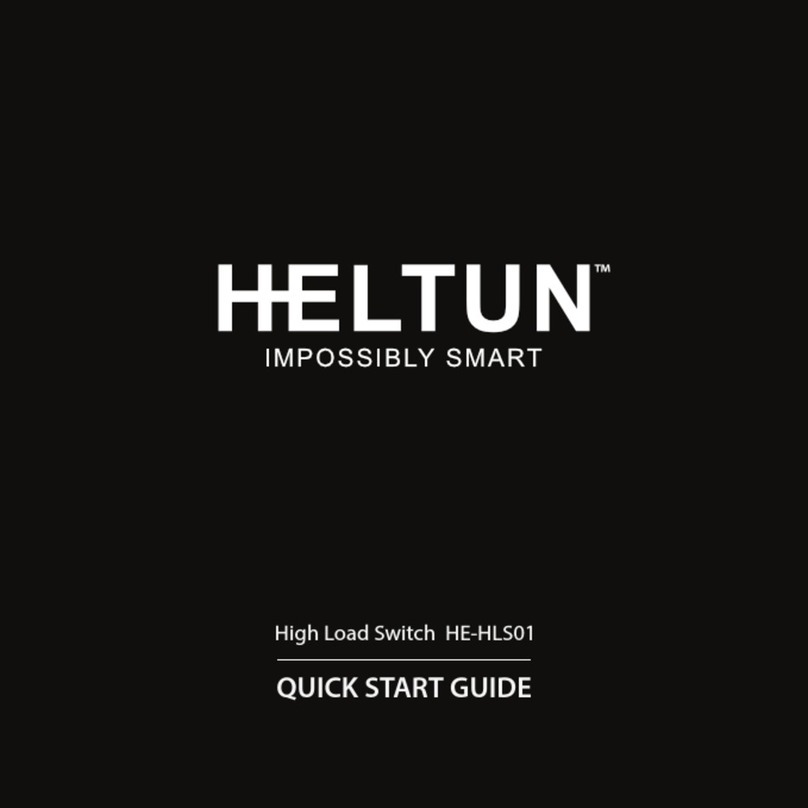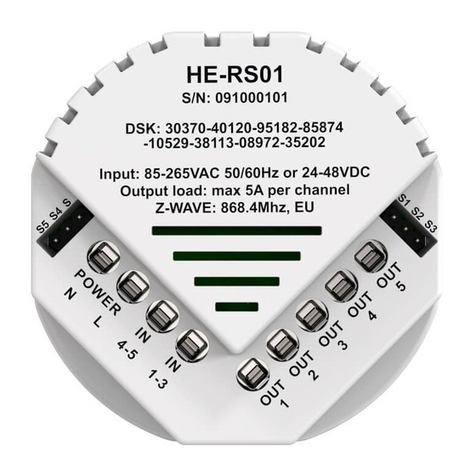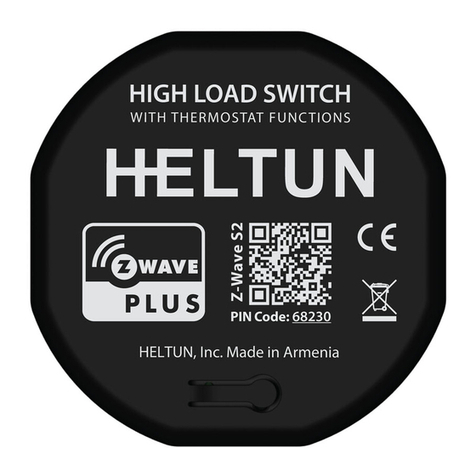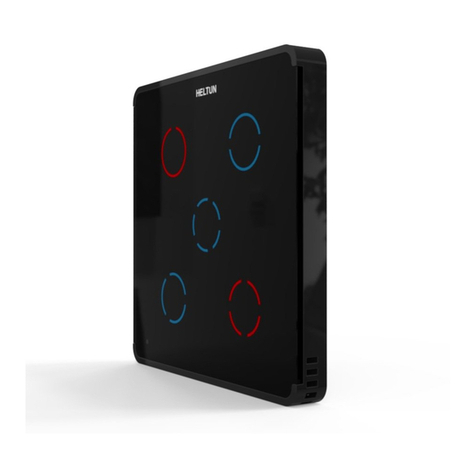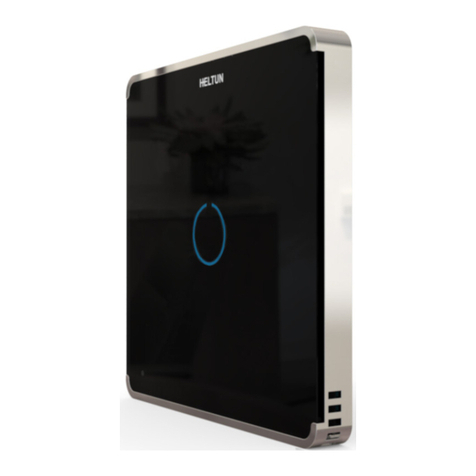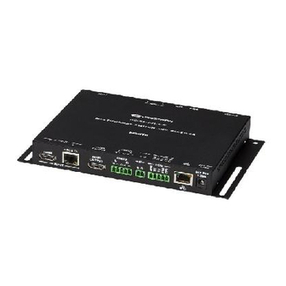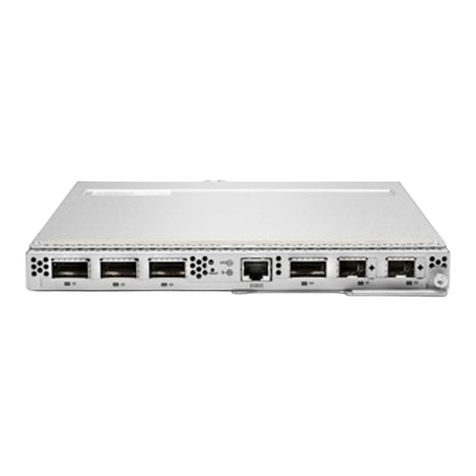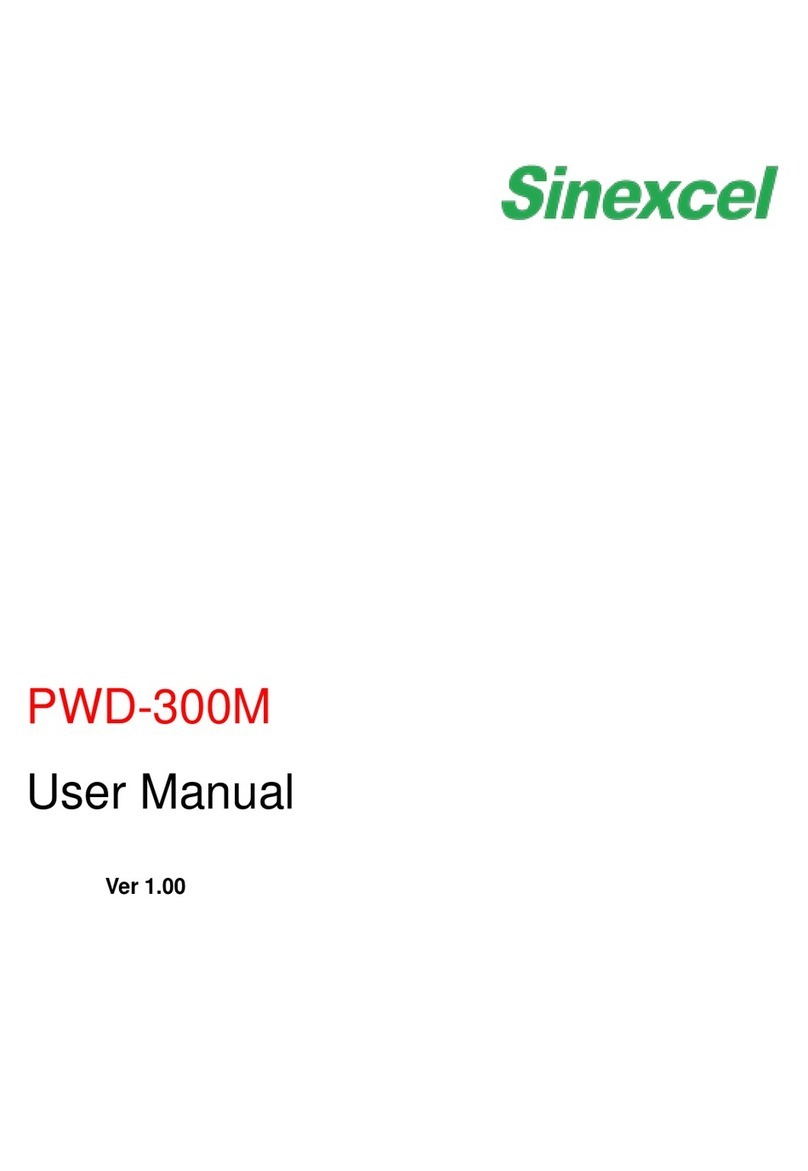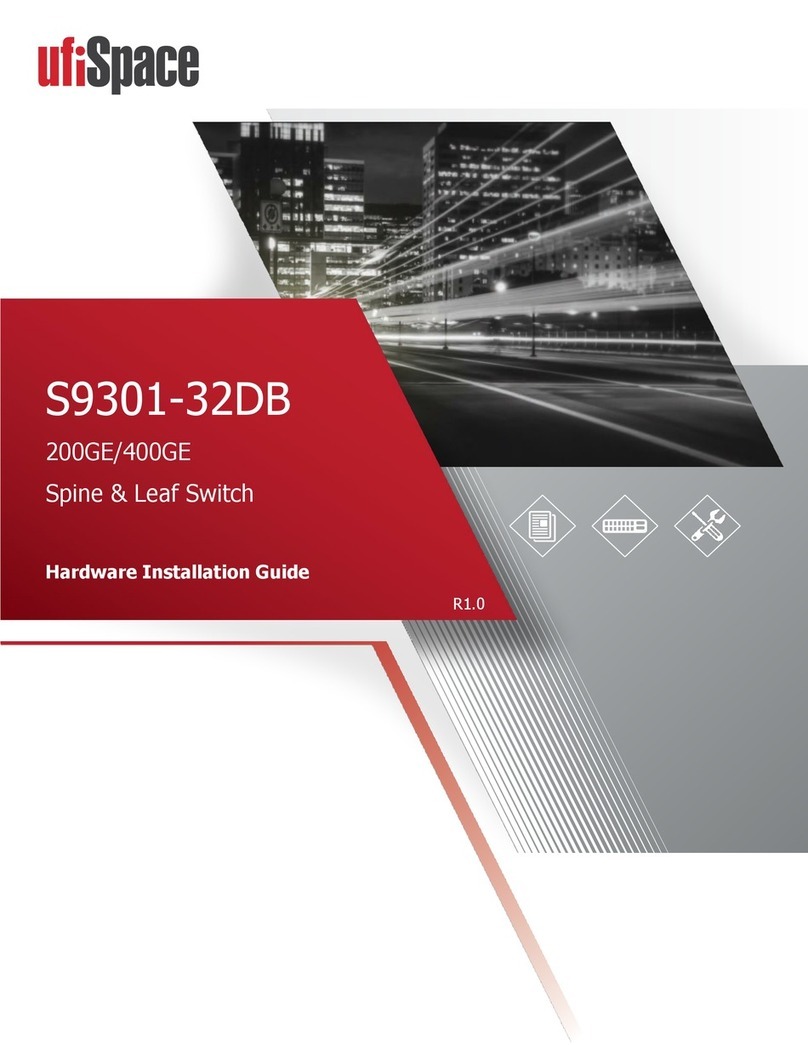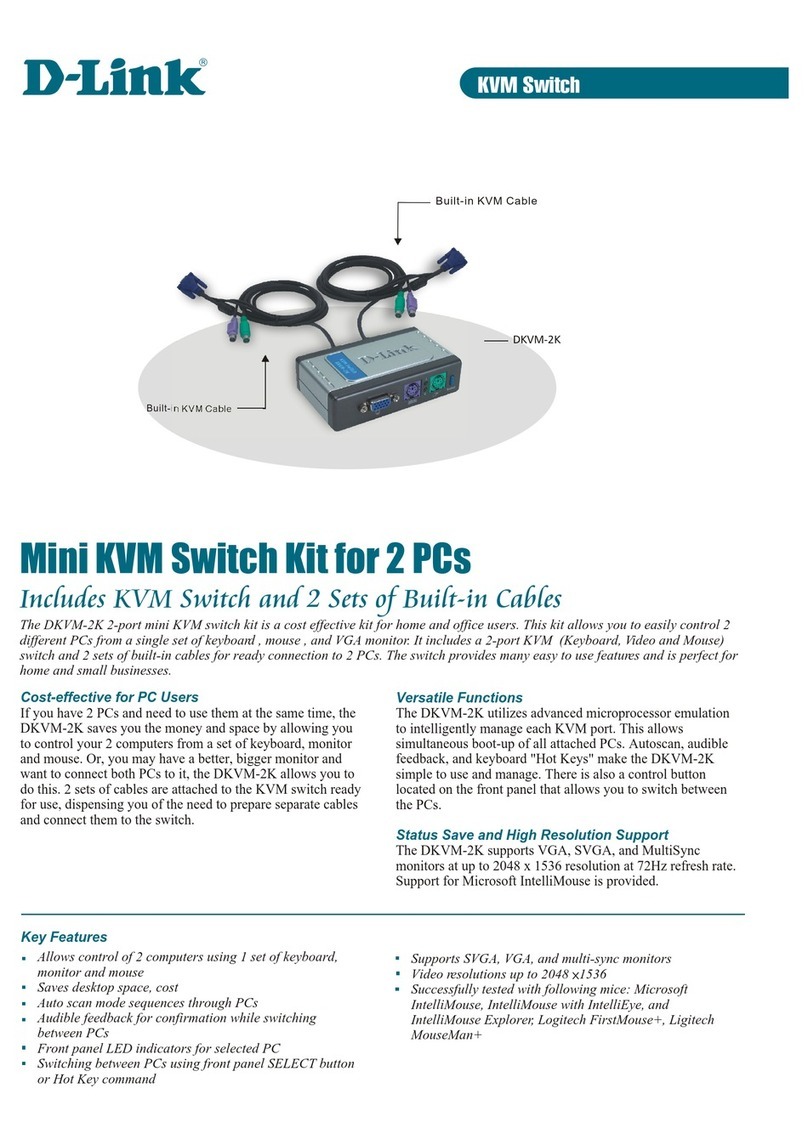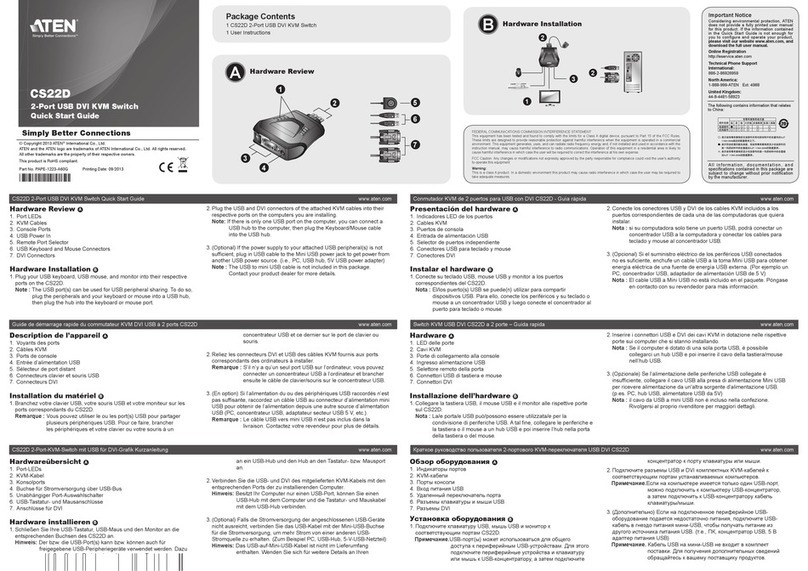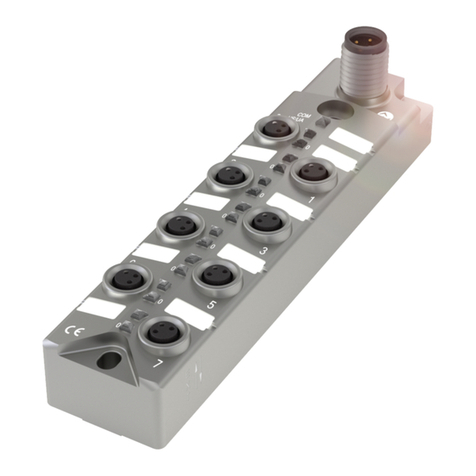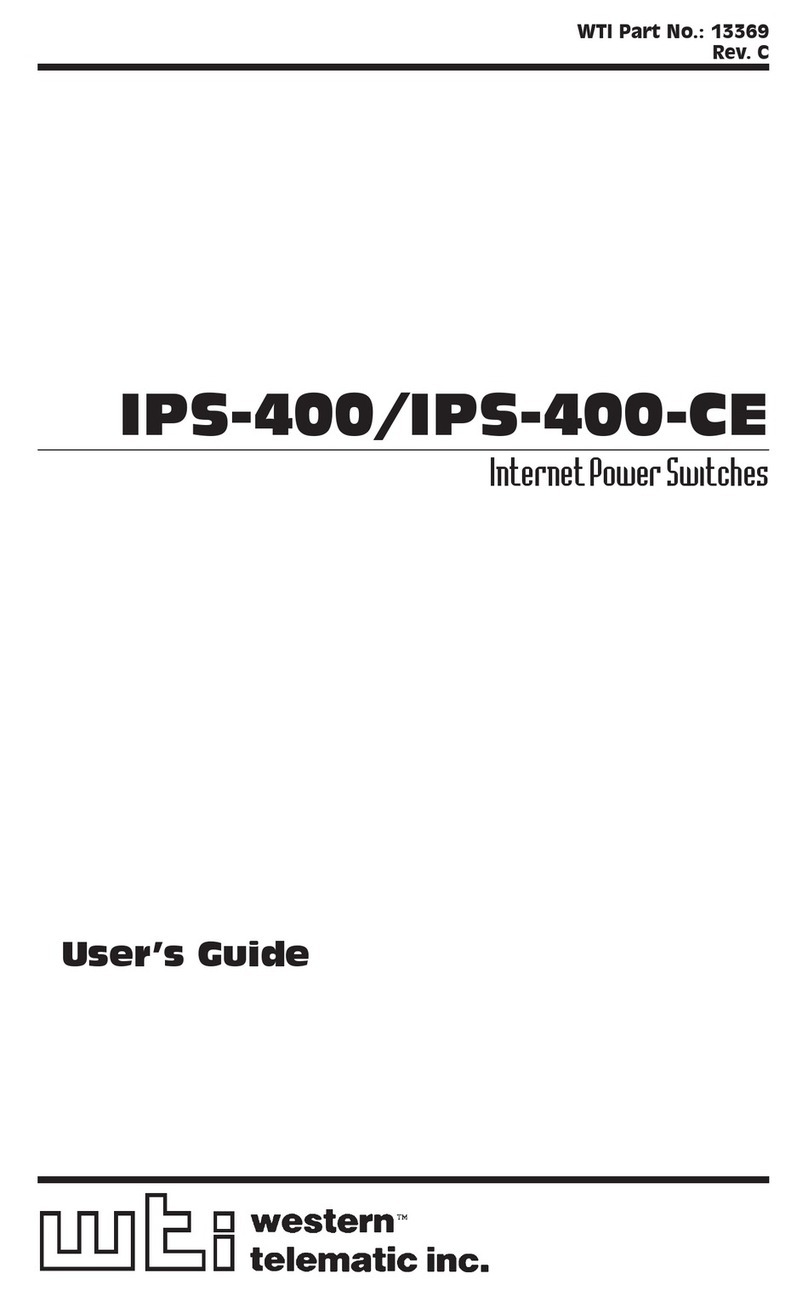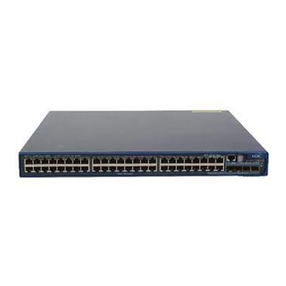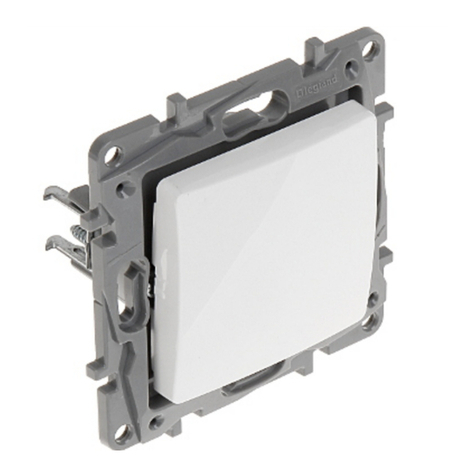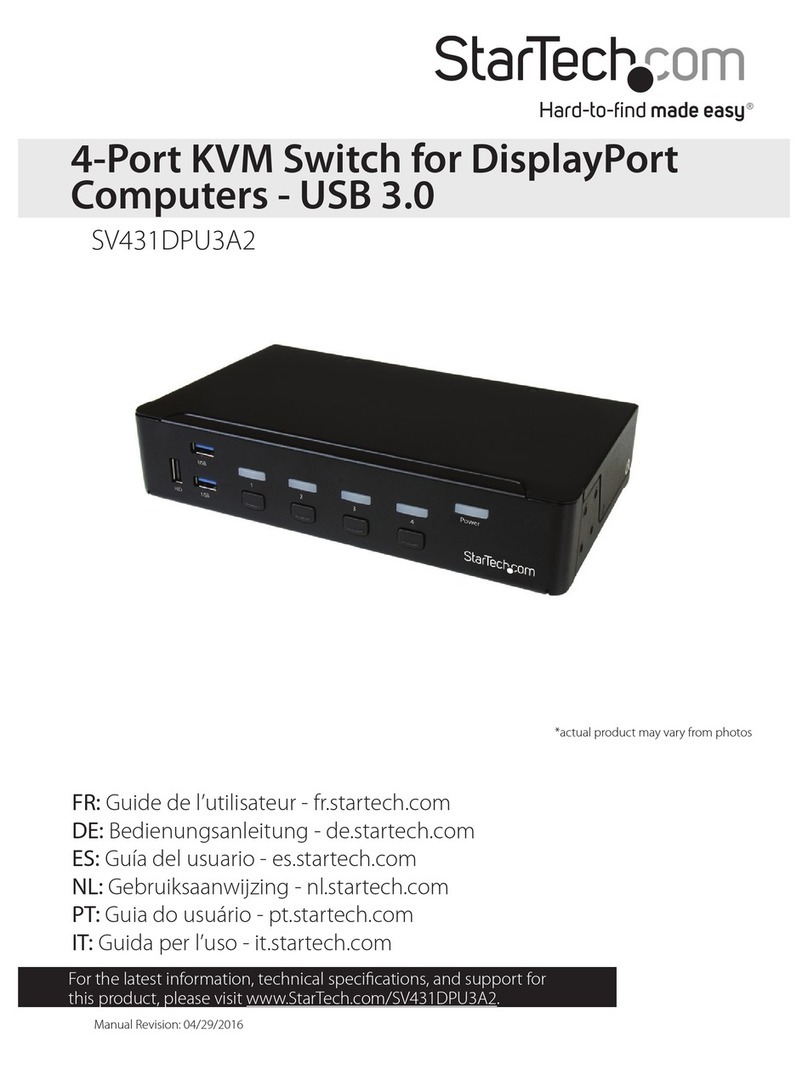Heltun HE-TPS01 User manual

TOUCH PANEL SWITCH SOLO
HE-TPS01 USER MANUAL
for Hardware v.60 & Firmware v.2.2

2
Table of Contents
Overview ...........................................................................................................................................................................3
Technical Specifications....................................................................................................................................................3
Functions & Features........................................................................................................................................................4
Installation.........................................................................................................................................................................5
Disassembly......................................................................................................................................................................6
Factory Reset....................................................................................................................................................................6
Z-Wave Network................................................................................................................................................................6
Adding to Z-Wave network...........................................................................................................................................6
Removing from Z-Wave network .................................................................................................................................6
Security ........................................................................................................................................................................6
SmartStart....................................................................................................................................................................7
Firmware OTA Update.................................................................................................................................................7
Z-Wave Plus v2 Specifications ....................................................................................................................................7
Associations.................................................................................................................................................................8
Touch Panel Operation .....................................................................................................................................................8
Settings (available through Z-Wave network)...................................................................................................................9
Parameters List & Factory Defaults .............................................................................................................................9
Z-Wave Frequency.....................................................................................................................................................11
Hardware & Software Versions..................................................................................................................................11
Power and Energy Consumption...............................................................................................................................11
Button Backlight Brightness.......................................................................................................................................11
Touch Sensitivity........................................................................................................................................................12
Output NO/NC Mode..................................................................................................................................................12
Temperature Sensor Calibration................................................................................................................................12
Time Configurations...................................................................................................................................................12
Backlight Control Source ...........................................................................................................................................12
Button Mode...............................................................................................................................................................13
Relay Mode................................................................................................................................................................13
Scenarios ...................................................................................................................................................................13
Sensors Report Interval .............................................................................................................................................14
Association Commands Configuration.......................................................................................................................15
Limited Warranty.............................................................................................................................................................16

3
Overview
This is the user manual for the HELTUN HE-TPS01 Advanced Programmable Touch Panel Switch. The HE-TPS01
brings ‘Impossibly Smart’ capabilities to your home lighting, electric outlets, door locks, gates, and valves. It replaces
an existing in-wall switch and brings over-the-Internet monitoring, control, and advanced programmability to one
connected device. Solo is ‘Impossibly Thin’ on the wall yet packed with features to provide the ultimate control and
convenience.
Controls system with up to 5A load
Thanks to Solo’s independent relay channel input it allows to control the system with any power source needs or to use
the relay output as dry contacts. The relay can be loaded up to 5 Amps.
Connects to Z-Wave lights and dimmers
Solo is an excellent choice for managing lighting systems. It allows connection to Z-Wave™ lights and dimmers
controlling both On and Off, as well as smooth brighten (Up) and smooth dim (Down) states. Dimmer levels can be tied
to Solo’s button backlight to provide feedback of connected light state (On/Off).
Controls devices
Solo can also be used to manage water valves and door locks. It also allows association with relay switches to control
connected devices. If door sensor is installed, it may be associated with Solo backlight, enabling it to indicate device
state (Open/Closed).
Touch panel button has multiple functions
Solo has one high sensitivity capacitive touch button with two-color backlights (red/blue). 10 backlight brightness levels
can be configured manually or set to automatically adjust to ambient light conditions making it always easy to see. The
button can be configured to control relay output state in any of eight different modes.
Five ways to trigger programmed scenarios
An onboard Real Time Clock (RTC) enables Solo to trigger scenarios where connected device is set to a schedule.
Another powerful feature lets Solo trigger connected device scenarios when temperature, humidity, or light sensor
values change. Solo button may also directly trigger scenarios on controller —with backlight indicating scene status.
Know how much energy you use
Solo can determine how much energy is used by connected device any particular day, week, or month. Just specify the
consumption of the load in watts for the relay channel and the device logic will calculate total consumption relative to
the time since the output was in the ‘ON’ state.
Based on the latest Z-Wave platform
Solo integrates a Z-Wave Plus™ v2 700 platform module allowing it to be used with Z-Wave home automation systems.
It supports Z-Wave ‘S0’ and ‘S2’ security protocols, SmartStart technology, and can be connected (“associated”) to
other Z-Wave devices, such as relays, motor controllers, dimmers, etc.
Technical Specifications
•Front frame (on wall) dimensions: 89mm (H) х89mm (W) х9mm (D)
•Rear electronics package dimensions: 53mm (H) х53mm (W) х28mm (D)
•Materials: Tempered glass display/body, Flame retardant plastic
•4 frame colors: White, Matte Black, Silver, Chrome
•6 glass colors: White, Black, Yellow, Green, Red, Blue
•1 capacitive-touch button
•Red and Blue LED backlights for the button
•10 brightness levels (adjustable) for the button backlight
•1 channel relay output, resistive load up to 5A
•Independent relay input, dry contact
•Operating temperature: 0°Сto +50°С
•Power supply: 85-265VAC 50Hz/60Hz or 24-48VDC
•Power consumption: 1W
•HELTUN Advanced Zero-Cross relay switching technology
•Relay lifetime: 100.000 switches
•Internal ambient light sensor
•Internal temperature sensor
oMeasurement range: –30°C to +80°C

4
oAccuracy: ±0.5°C
•Internal humidity sensor
oMeasurement range: 0% to 80%RH
oAccuracy: ±3.0%RH
•IP class: IP21
•Z-Wave Plus V2 SDK: V7.11
•Z-Wave module: ZGM130S
•Requires mounting to flush electrical junction box:
round or square type –min. depth 40mm
Functions & Features
•Options for Inclusion/Exclusion to/from Z-Wave network
oNon-Secure
oS0 Secure
oS2 Unauthorized, S2 Authorized with Key
•Association control of Z-Wave devices in the network
•Schedule Mode
•The button can be set up to control devices from associated groups
•The button backlight & the relay output can be managed by a gateway or associated device
•The button can trigger scenes
•The button backlight can indicate a scene, or associated device state
•The channel may be excluded from control
•Eight modes for the button:
1. Momentary
2. Momentary Reversed
3. Momentary Toggle
4. Toggle
5. Switch ON Only
6. Switch OFF Only
7. Timer (ON to OFF)
8. Timer Reversed (OFF to ON)
•Adjustable periodic measurements from:
oInternal temperature sensor
oInternal humidity sensor
oInternal ambient light sensor
oEnergy consumption meter
•Calibration of Internal Room Air Temperature Sensor
•Brightness control of button backlight:
oAutomatic adjustment (depending on ambient light)
oManual adjustment (10 levels).
•Backlight standby mode (different brightness for active and inactive states)
•Backlight blinking function (for easy identification among other Z-Wave devices)
•Backlight colors invert
•Software energy consumption logic
•Factory reset function
•SmartStart technology for quick addition to Z-Wave networks
•OTA (Over The Air) encrypted firmware update

5
Installation
HELTUN recommends the HE-TPS01 touch panel switch be installed by a licensed electrician in a
manner that conforms to local regulations and building codes. Provide these instructions to the
licensed electrician who is installing the HE-TPS01.
Note: It is not recommended to install the device in rooms with high humidity such as bathroom or
sauna.
WARNING: Electrical power must be switched off during installation.
1. Placement of the HE-TPS01 is of utmost importance for proper operation and must be away
from sunlight and sources of direct heat. We recommend installing the HE-TPS01 approximately
1.5 meters above the floor.
2. Remove the touch panel unit and backplate of the HE-TPS01 from the packaging.
3. FIRST ENSURE THE POWER IS OFF at the main circuit breaker (Fig. 1), and then test the
wires with a probe or multimeter to verify. Insert the power wires to the HE-TPS01 “POWER”
terminal by inserting a small Phillips-head screwdriver in the slot beneath each terminal and
unscrew to open. Follow Fig. 2: Connection Diagram and instructions below:
• Power wires: for AC power (85-265VAC) connect Line & Neutral wires to L & N terminals
labeled “POWER” (Fig 2. left diagram). For DC power (24-48VDC) connect “+” wire to terminal N and “-” wire to
terminal L (Fig 2. right diagram).
• Source wire: connect the required power source for the relay output to the terminal labeled “IN 1-3”.
• Load: connect the required load to the relay output terminals labeled “OUT-1”.
Note: HELTUN recommends installing cord terminals (electric wire ferrule) on the ends of wires before connecting
them to the HE-TPS01 outputs (various colors terminals are included in the packaging).
4. Make sure the HE-TPS01 backplate is oriented on the wall with the word “TOP”
pointed upwards. Then secure the backplate onto the electrical junction box using
the four screws provided (do not overtighten). Once the backplate is secured onto
the wall, assemble the HE-TPS01 touch panel unit onto the backplate by first
carefully aligning the two top snap connectors (Fig. 3), and then gently pushing the
entire display unit until it ‘snaps’ into position all the way around.
5. Next, switch ON the main power at the circuit breaker (see photo above). The HE-
TPS01 will start up with original default factory settings (the button backlight will
indicate red).
6. Remove the clear protective film from the touch panel unit and frame by pulling on
the top right-hand orange color tabs.
Note: Zero-Cross technology is unavailable if the device operates using DC voltage (24-
48VDC).
Figure 2: Connection Diagrams
Figure 1:
Circuit Breaker
Figure 3: Install
Touch Panel Unit

6
Disassembly
1. To disassemble, ENSURE POWER IS SWITCHED OFF at the main circuit breaker AND THE BUTTON
BACKLIGHT IS OFF.
2. To remove the HE-TPS01 touch panel unit, grasp firmly at the bottom and pull backwards while tilting outwards
until all tabs are disconnected.
3. Remove screws from backplate and disconnect the wires by inserting a small Phillips-head screwdriver into the
slot beneath of each wire, then unscrew to release.
Factory Reset
To reset the HE-TPS01 to factory defaults, simultaneously press the two bottom hidden touch buttons and hold for 6
seconds. If successful, the central button will turn OFF then the device will reboot.
The factory reset will change all the Parameters to their original factory default values (including Z-Wave frequency) and
will also Exclude the device from any Z-Wave network.
Note: Please use Factory Reset only when the primary network controller is missing or otherwise inoperable.
Z-Wave Network
The HE-TPS01 may be operated in any Z-Wave network with other Z-Wave certified devices from other manufacturers.
The HELTUN HE-TPS01 will act as a ‘repeater’ (i.e. ‘range extender’) for other devices regardless of manufacturer or
brand to increase the reliability of the overall network.
Adding to Z-Wave network
To add the HE-TPS01 into a Z-Wave network (i.e. “Inclusion”), do the following:
1. Start the Inclusion Mode from the gateway/controller.
2. To start the inclusion process on the HE-TPS01, simultaneously press the two upper hidden touch buttons and hold
them for three seconds.
3. The central button will then sequentially blink blue –red.
4. If the inclusion has been successful, the button will turn blue for three seconds.
5. If the inclusion was not successful, the button will turn red for three seconds. In that case repeat the inclusion process.
Note: For correct operating in Fibaro gateways, the Single Channel Association should be removed from the device
LifeLine (EndPoint 0 Group 1).
Removing from Z-Wave network
To remove the HE-TPS01 from a Z-Wave network (i.e. “Exclusion”), do the following:
1. Start the Exclusion Mode from the gateway/controller.
2. To start the exclusion process on the HE-TPS01, simultaneously press the two upper hidden touch buttons and hold
them for three seconds.
3. The central button will sequentially blink blue - red.
4. If the exclusion has been successful, the button will turn red for three seconds.
5. If the exclusion was not successful, the button will turn blue for three seconds. In that case repeat the exclusion
process.
Note: If the HE-TPS01 has previously been part of a Z-Wave network and
has not been Excluded since, inclusion is not possible without first
performing an Exclusion or Factory Reset procedure.
Security
S0, S2 unauthorized, and S2 authorized Inclusion Modes are supported. If
you use the S2 authorized Inclusion Mode the security key should be used
during the inclusion process. Security key is the first 5 digits of DSK (device
DSK is printed on the HE-TPS01 back panel plus on the Security Card
included in the packaging).
Note: Be sure to save this key. Without the key, it is impossible to perform
an inclusion in S2 authorized mode.

7
SmartStart
SmartStart-enabled products can be added to a Z-Wave network by scanning the Z-Wave QR Code shown on the
product with gateways/controllers that allow for SmartStart inclusion. In this case, no further action will be required and
the SmartStart product will be added automatically within ten minutes of being turned on in the vicinity of a network.
To add the HE-TPS01 to a Z-Wave network using SmartStart:
1. Input the HE-TPS01 DSK code to the controller's Node Provisioning List (or scan the QR code).
2. Power on the device.
3. Wait for the inclusion process to complete.
4. Successful adding” will be confirmed by a message on the Z-Wave controller.
Note: The device DSK and QR code are printed on the HE-TPS01 back panel plus on the Security Card included in the
HE-TPS01 packaging.
Firmware OTA Update
To wirelessly update the HE-TPS01 firmware, follow these steps:
1. Check the device current firmware version in the gateway/controller.
2. Start the process from the Z-Wave gateway/controller.
3. Download the latest firmware that corresponds to the HE-TPS01 (see support.heltun.com)
4. Set the main controller in Firmware OTA (“over-the-air”) Update Mode (see the gateway/controller manual).
5. As soon as the Firmware update begins, the button will sequentially blink blue-red (this will take a few minutes).
6. When the Firmware has updated, the button backlight will turn blue then turn off for two seconds and the HE-TPS01
will reboot.
7. When the update has been completed, the HE-TPS01 will return to normal operation.
8. If desired, verify the update was successful by checking firmware version from the gateway/controller.
Z-Wave Plus v2 Specifications
Generic Device Class: GENERIC_TYPE_WALL_CONTROLLER
Specific Device Class: SPECIFIC_TYPE_NOT_USED
Supported Command Classes
Command Class
Version
Required Security Class
Z-Wave Plus Info
V2
none
Association
V2
highest granted (S2 Authenticated, S2 Unauthenticated or S0)
Association Group Info
V3
highest granted (S2 Authenticated, S2 Unauthenticated or S0)
Multi Channel Association
V3
highest granted (S2 Authenticated, S2 Unauthenticated or S0)
Multi Channel
V4
highest granted (S2 Authenticated, S2 Unauthenticated or S0)
Switch Binary
V2
highest granted (S2 Authenticated, S2 Unauthenticated or S0)
Central Scene
V3
highest granted (S2 Authenticated, S2 Unauthenticated or S0)
Sensor Multilevel
V11
highest granted (S2 Authenticated, S2 Unauthenticated or S0)
Meter
V5
highest granted (S2 Authenticated, S2 Unauthenticated or S0)
Clock
V1
highest granted (S2 Authenticated, S2 Unauthenticated or S0)
Transport Service
V2
none
Security 0
V1
none
Security 2
V1
none
Version
V3
highest granted (S2 Authenticated, S2 Unauthenticated or S0)
Manufacturer Specific
V2
highest granted (S2 Authenticated, S2 Unauthenticated or S0)
Device Reset Locally
V1
highest granted (S2 Authenticated, S2 Unauthenticated or S0)
Powerlevel
V1
highest granted (S2 Authenticated, S2 Unauthenticated or S0)
Supervision
V1
none
Indicator
V3
highest granted (S2 Authenticated, S2 Unauthenticated or S0)
Configuration
V4
highest granted (S2 Authenticated, S2 Unauthenticated or S0)
Application Status
V1
none
Firmware Update Meta Data
V5
highest granted (S2 Authenticated, S2 Unauthenticated or S0)
Basic
V2
highest granted (S2 Authenticated, S2 Unauthenticated or S0)
Meter Command Class:
Meter Type
Scale
Rate Type
Precision
Size
Electric [0x01]
Electric_kWh [0x00]
Import [0x01]
2
4
Electric [0x01]
Electric_W [0x02]
Import [0x01]
0
2

8
Associations
Association enables the HE-TPS01 to control other Z-Wave devices over the network. The HE-TPS01 has 3 Endpoints
and 5 Association Groups. Each Association Group (except group 1) may include one other device from different brands
and/or manufacturers.
EndPoint 0 Groups:
The Root Device (EndPoint 0) of HE-TPS01 has 5 association groups
Group 1 –“Lifeline”: reports full state of the device and is used to communicate with the Z-Wave gateway. The
group supports one Node.
Note: It is not recommended to modify this group.
Note: For correct operating in Fibaro gateways, the Single Channel Association should be removed from the device
LifeLine (EndPoint 0 Group 1).
Group 2 –“Touch Basic Set”: is assigned to touch N1. Is used to send Basic Set ON (value 255) and Basic Set OFF
(value 0) commands to the associated devices. Max supported nodes: 1.
Group 3 –“Touch Multilevel Set”: is assigned to touch N1. It sends MULTILEVEL SWITCH command class frame
when touch N1 was held. Is used to send UP/DOWN command to the associated devices. Max supported nodes: 1.
Group 4 –“LED Basic Set”: is assigned to LED N1. Is used to send Basic Set ON (value 255) and Basic Set OFF
(value 0) commands to the associated devices. Max supported nodes: 1.
Group 5 –“Relay Basic Set”: is assigned to relay N1. Is used to send Basic Set ON (value 255) and Basic Set OFF
(value 0) commands to the associated devices. Max supported nodes: 1.
EndPoints 1-2 Groups:
Group 1 –“Lifeline”: reports state of the device and used to communicate with the Z-Wave gateway. The group
supports one Node.
Note: It is not recommended to modify this group.
Group 2 –“Basic Set”: Is used to send Basic Set ON (value 255) and Basic Set OFF (value 0) commands to the
associated devices. The group supports one Node and it is mapped to EndPoint 0 groups.
Here is a truth table for EndPoints 1-2 groups mapping to the root device (EndPoint 0) groups:
EndPoints 1-10 groups
Root (EndPoint 0) groups
Endpoint 1, Group 2 –“LED Basic Set”
Group 4 –“LED Basic Set”
Endpoint 2, Group 2 –“Relay Basic Set”
Group 5 –“Relay Basic Set”
Gateway compatibility requirement:
In order to make a reliable connection and data exchange with the gateway make sure that the gateway/controller is
multi-channel capable. The gateway/controller lifeline association should be configured as a “multi-channel association.”
Some Gateways need this option to be manually configured.
Note: Fibaro Home Center 2: In order to enable correct communications between a Fibaro Gateway/Controller and
the HE-TPS01, the lifeline association should be configured as a “multi-channel association.” Make sure that only the
Multi-channel association check box is selected under Device > Settings > Advanced > Setting Association > Group1
tab (lifeline).
Note: By default, there are two checkboxes for Single-channel and Multi-channel associations. Please deselect the
checkbox under Single-channel associations.
Touch Panel Operation
The HE-TPS01 has one relay, one touch button and two-color (red and blue) backlight for the button.
1. The relay can be controlled by the touch button or via a Z-Wave network (using a Z-Wave gateway).
2. The touch button can be configured to control the relay output state in the modes below:
1) MOMENTARY: When the button is held the relay output is ON, as soon as the button is released the relay output
state changes to OFF (see Parameter 41 settings).
2) MOMENTARY REVERSED: When the button is held the relay output is OFF, as soon as the button is released
the relay output state changes to ON (see Parameter 41 settings).
3) MOMENTARY TOGGLE: When the button is held, the relay output inverts state (from ON to OFF or from OFF
to ON), as soon as the button is released the relay output inverts state again (see Parameter 41 settings).

9
4) TOGGLE: On the button each press the relay output inverts state (from ON to OFF or from OFF to ON) (see
Parameter 51 settings).
5) SWITCH ON ONLY: On the button press the relay output switches to ON state only (see Parameter 51 settings).
Note: If the relay output is already in ON state, nothing will change.
6) SWITCH OFF ONLY: On the button press the relay output switches to OFF state only (see Parameter 51
settings).
Note: If the relay output is already in OFF state, nothing will change.
7) TIMER (ON to OFF): On the button press the relay output switches to ON for the specified time, then reverts to
OFF (see Parameter 51 settings).
Note: Time can be configured from 0 sec to 43200 sec (12 hours).
8) TIMER REVERSED (OFF to ON): On the button press the relay output switches to OFF for the specified time
then reverts to ON (see Parameter 51 settings).
Note: Time can be configured from 0 sec to 43200 sec (12 hours).
Tip: This function is useful for switching OFF security system or door lock for a short time.
The touch button can also be used to run scenarios or change modes in the connected gateway or associated devices.
3. The button’s backlight can be configured as follows to indicate:
a) Relay output state
b) Touch button state
c) Mode state in connected gateway
d) Associated device state
Note: It is possible to choose the light color for each state: red for ON and blue for OFF, or blue for ON and red for OFF
(see Parameter 30 settings).
If the HE-TPS01 is included to the Z-Wave gateway, the scene controller, light, temperature & humidity sensors info,
and two binary switches will appear. The scene controller indicates if the button was pressed, held, or released and
allows the running of scenes on the Z-Wave gateway. The first binary switch indicates and control the button backlight.
The second binary switch indicates and control the relay output.
Settings (available through Z-Wave network)
All configuration parameters are accessed through Z-Wave COMMAND_CLASS_CONFIGURATION
Parameters List & Factory Defaults
Number
Size
Description
Default
Value
Available Values
1
1 byte
Frequency Region
Read
Only
0 … 9
2
Reserved by the manufacturer
3
4 bytes
Hardware and Software Versions
Read
Only
XXYYZZ
4
4 bytes
Energy Consumption, kW
Read
Only
Total
consumption
5
1 byte
Backlight brightness control
0
0, 1 … 10
6
1 byte
Touch button sensitivity. 1 = Lowest; 10 = Highest
6
1 … 10
7
1 byte
Relay output NO or NC mode
0
0, 1
8-11
Reserved by the manufacturer
12
2 bytes
Power of the Relay load in W
0
0…1100
13-16
Reserved by the manufacturer
17
1 byte
Air Temperature Calibration in °C, value X 10, e.g. 1.0°C=10
0
-100 … 100
18
Reserved by the manufacturer
19
1 byte
Time correction by controller
1
0, 1
20
Reserved by the manufacturer

10
21
1 byte
Week Day
1
1, 2, 3, 4, 5, 6, 7
22
2 bytes
Time: Hour and Minutes
0
0 … 2359
23-29
Reserved by the manufacturer
30
1 byte
Active state backlight color
1
0, 1
31
1 byte
Backlight control source
1
0, 1, 2
32-40
Reserved by the manufacturer
41
1 byte
Hold control mode for the touch button
2
0, 1, 2, 3, 4
42-50
Reserved by the manufacturer
51
1 byte
Click control mode for the touch button
1
0, 1, 2, 3, 4, 5, 6
52-60
Reserved by the manufacturer
61
1 byte
Relay control source
1
0, 1
62-70
Reserved by the manufacturer
71
2 bytes
Timer mode duration for the button
0
0 to 43200
72-110
Reserved by the manufacturer
111
4 bytes
Relay control scenario 1
0
0, 10000000 to
13112359
112
4 bytes
Relay control scenario 2
0
0, 10000000 to
13112359
113
4 bytes
Relay control scenario 3
0
0, 10000000 to
13112359
114
4 bytes
Relay control scenario 4
0
0, 10000000 to
13112359
115
4 bytes
Relay control scenario 5
0
0, 10000000 to
13112359
116
4 bytes
Relay control scenario 6
0
0, 10000000 to
13112359
117
4 bytes
Relay control scenario 7
0
0, 10000000 to
13112359
118
4 bytes
Relay control scenario 8
0
0, 10000000 to
13112359
119
4 bytes
Relay control scenario 9
0
0, 10000000 to
13112359
120
4 bytes
Relay control scenario 10
0
0, 10000000 to
13112359
121-140
Reserved by the manufacturer
141
1 byte
Consumption meter consecutive reporting interval, minutes
10
1 … 120
142
1 byte
Consumption change report to send to controller
1
0, 1
143
1 byte
Sensors consecutive reporting interval, minutes
10
1 … 120
144
1 byte
Temperature difference to send to controller, value X 10
2
0, 1 … 100
145
1 byte
Humidity difference to send to controller, %
2
0, 1 … 25
146
1 byte
Light sensor values difference to send to controller, %
50
0, 10 … 99
147-170
Reserved by the manufacturer
171
1 byte
Touch control mode for associations with the touch button
0
0, 1, 2

11
Z-Wave Frequency
Parameter 01 –Frequency Region
The HE-TPS01 has Z-Wave 700 series chip inside which allows to use the device in different Z-Wave frequencies. If
there is a need to use the device in the frequency different from the factory default, change the value of this Parameter
according to the frequency list below. Modification is possible only while the HE-TPS01 is not included to Z-Wave
network.
Note: The factory default frequency differs depending on which region the device was intended for sale in. Check the
factory default frequency on the device plate or on the packaging.
Note: Do not change this Parameter value if there is no special need.
Note: If change the value of this Parameter, the frequency change will be applied only after removing the device from
Z-Wave network (the device will automatically reboot).
Note: The change of this Parameter will result in inability to control the device, if the device was included to the
controller/gateway which supports only one frequency.
Note: Resetting the device to factory default settings will revert the frequency to the factory default value.
Note: In most of countries it is not allowed to use the frequency different from the frequency intended for that country.
Frequency list for different regions:
0: EU (868.4 MHz, 869.85 MHz)
1: US (908.4 MHz, 916.0 MHz)
2: ANZ (919.8 MHz, 921.4 MHz)
3: HK (919.8 MHz)
4: IN (865.2 MHz)
5: IL (916.0 MHz)
6: RU (869.0 MHz)
7: CN (868.4 MHz)
8: JP (922.5 MHz, 923.9 MHz, 926.3 MHz)
9: KR (920.9 MHz, 921.7 MHz, 923.1 MHz)
The full list of Z-Wave global regions where Z-Wave works is available at Z-Wave Global Regions SiLabs page.
Hardware & Software Versions
Parameter 03 –Hardware and Software Versions
This Parameter allows to check the hardware and firmware versions of the device. The Parameter returns value in the
format XXYYZZ, where XX is Hardware Version, YY is Firmware Major Version and ZZ is Firmware Minor Version.
Note: This Parameter is read-only.
Power and Energy Consumption
Parameter 04 –Energy Consumption
This Parameter allows to check the Cumulative Energy Consumption (in kW) of the connected load.
HE-TPS01 monitors Real-Time and Cumulative power Energy Consumption of connected load using advanced software
logic which measures the consumption based on load power value set in Parameter 12.
Cumulative Energy Consumption is the total electrical power being used by connected load since the Parameter 04
value last reset. Power usage is calculated by the software using the values that were manually set when configuring
Parameter 12, multiplied by the time tracked when the HE-TPS01 corresponding output was in ON state.
Real-Time Consumption and Cumulative Consumption are periodically reported to the Z-Wave controller according to
the Parameters 141 and 142 settings.
Note: This Parameter is read-only.
Resetting Cumulative Consumption memory:
The HE-TPS01 enables you to erase stored Consumption Data through the Z-Wave network as follows:
1. Make sure the HE-TPS01 is powered.
2. If not already done so, include the device into Z-Wave Gateway network.
3. Reset memory consumption data using the Reset Command in COMMAND_CLASS_METER (see the Gateway
owner’s manual).
Note: Turning the device main power off/on will not erase the consumption data as it is stored in nonvolatile memory.
Parameter 12 –Relay Load Power in watt
This Parameter is used to specify the load power that are connected to the device output. Using your connected device’s
power consumption specification (see associated owner’s manual), set the load in Watts. The factory default value is 0.
Note: The range from 0 to 1100 watt can be selected.
Button Backlight Brightness
The HE-TPS01 has two brightness levels for its button backlight: 1) Active Level –when the button is touched, its
backlight becomes brighter, and 2) Inactive Level –after one second of inactivity, its backlight dims. The actual
brightness level may be adjusted manually or automatically.

12
Parameter 05 –Brightness Control
The HE-TPS01 can adjust its button backlight brightness automatically depending on the illumination of the ambient
environment and also allows to control it manually. Set the Parameter value to 0 to activate the Automatic Brightness
Control or set from value 1 (lowest brightness) to 10 (highest brightness) for Manual Control. The factory default value
is 0.
Touch Sensitivity
Parameter 06 –Touch Sensor Sensitivity Threshold
This Parameter allows the device Touch Button Sensitivity Threshold to be adjusted from level 1 (low sensitivity) to 10
(high sensitivity). The factory default value is 6.
Note: Setting the sensitivity too high can lead to false touch detection. We recommend not changing this Parameter
unless there is a special need to do so.
Output NO/NC Mode
Parameter 07 –Output NO/NC Mode
This Parameter determines the type of load connected to the device relay output. The output type can be NO –normal
open (no contact/voltage to switch the load OFF) or NC - normal close (output is contacted / there is a voltage to switch
the load OFF). Choose the value 0 if NO contact type is required or value 1 if NC type is required. The factory default
value is 0 (NO mode).
Temperature Sensor Calibration
Parameter 17 –Air Temperature Calibration
This parameter defines the offset value for room air temperature. If the internal air temperature sensor is not correctly
calibrated, then manual calibration can be made by adjusting the values up to ±10°C. This value will be added or
subtracted from the internal air temperature sensor reading. The value of this Parameter should be x10, e.g. for 1.5°C
set the value 15. The factory default value is 0
Time Configurations
Parameter 19 –Time Correction by Main Controller
If this Parameter value = 1 and the HE-TPS01 is connected to a Z-Wave gateway, the HE-TPS01 time and day will be
periodically polled and corrected from the gateway. To switch off auto-correction set the Parameter value to 0. The
factory default value is 1.
Parameter 21 –Day of the Week Manual Adjustment
This Parameter allows manual adjustment of the day of the week in case the HE-TPS01 is not connected to any Z-
Wave gateway or auto-correction is disabled (Parameter 19 value is 0). 1 = Monday, 2 = Tuesday, 3 = Wednesday, 4 =
Thursday, 5 = Friday, 6 = Saturday, 7 = Sunday. The factory default value is 1.
Parameter 22 –Time Manual Adjustment
This Parameter allows manual adjustment of Time. The Parameter has the following format: HHMM, where HH is hours
and MM is minutes. E.g. for 16:08 set the value 1608 and for 1:00 set the value 100.
Backlight Control Source
Parameter 30 –Button Backlight Color
Choose the value “1” if you wish the backlight active state to be blue, and the inactive state to be red (default). Choose
the value “0” if you wish the backlight active state to be red, and the inactive state to be blue. The factory default value
is 1.
Parameter 31–Button Backlight Control Source
0 –Backlight is disabled (both color LEDs are turned off)
1 –Backlight is controlled by touch button (reflects the button state)
2 –Backlight is controlled by gateway or associated device (the button state is ignored)
The factory default value is 1.
Note: If the backlight is disabled (the Parameter value is set to “0”), it is also impossible to control it from the gateway.

13
Button Mode
Parameter 41 –Button Hold (Long Press) Control Mode.
0 –Hold function is disabled
1 –Operate like click
2 –When the button is held the relay output state is ON, as soon as the button is released the relay output state changes
to OFF (momentary switch).
3 –When the button is held the relay output state is OFF, as soon as the button is released the relay output state
changes to ON (momentary switch).
4 –When the button is held or released the relay output state will toggle its state (ON to OFF or OFF to ON).
The factory default value is 2.
Note: Regardless of this Parameter, the device will send scene notifications about the touch state (pressed, held,
released) to the gateway.
Parameter 51 –Button Click (Short Press) Control Mode
0 –Press function disabled
1 –Relay inverts state (toggles ON to OFF, OFF to ON) according to the relay state
2 –Relay inverts state (toggles ON to OFF, OFF to ON) according to the button backlight state.
3 –Relay switches to ON state only
4 –Relay switches to OFF state only
5 –Timer: On>Off Mode: Relay output switches to ON state (contacts are closed) then after a specified time switches
back to OFF state (contacts are open). The time is specified in Parameter 71.
6 –Timer: OFF>ON Mode: Relay output switches to OFF state (contacts are open) then after a specified time switches
back to ON state (contacts are closed). The time is specified in Parameter 71.
The factory default value is 1.
Relay Mode
Parameter 61 –Button Number for Relays Output Control
0 –Controlled by gateway or associated device
1 –Controlled by touch button
Factory default value: 1.
Parameter 71 –Relay Timer mode duration
This Parameter specifies the duration in seconds for the Timer mode (values 5 or 6 in Parameter 51 respectively). Press
the button and the relay output goes to ON/OFF for the specified time then changes back to OFF/ON. This function can
be used to turn attached devices like door lock or security OFF for a short time. The time values can be configured from
0 sec to 43200 sec (12 hours). The factory default value is 0.
Note: If the parameter value is set to “0” it will operate as a short contact (about 0.5 sec).
Scenarios
Scenarios can be created that allow connected devices to be triggered by a sensor or onboard Real Time Clock (RTC).
The HE-TPS01 has built-in temperature, humidity, and ambient temperature sensors and includes a very flexible, user-
friendly interface for customizing scenarios. In addition to the physical sensors, time may be used as a control source.
The user should configure the output number, state, sensor type, state change condition, and threshold in the
Parameters (from 111 - 120) which will trigger the scenes.
Parameters 111-120- Relay Control by Sensors
In these Parameters, the relay state changes depending on sensor threshold value. For these configurations, Parameter
values are encoded as 8-digit numbers (ABCDEFGH):
A = Relay number (can be only 1)
B = Control Mode
0-Temperature Sensor,
1-Humidity Sensor,
2-Light Sensor,
3-Time control
C = State change relative to value in EFGH Condition Value fields (see below)
0-Equal or lower than
1-Equal or higher than
D: State Change,
0-Switch OFF
1-Switch ON

14
EFGH: Condition Value
“Sensor Value” for Control modes 0, 1, and 2, or “Time” for Control mode 3.
If Temperature sensor has been chosen as a source in the control mode, the value should be x10, e.g. for 24.5°C
use the value 0245.
If Time control has been chosen as a source in the control mode, the device logic will process values EFGH from 0
to 23:59 (in time measure), all other values will be ignored.
EF represents Hour (0 through 23), GH represents Minutes (0 through 59).
All other numbers are reserved and will not affect the operation. To disable this option simply set this Parameter to 0.
The factory-default value: “0”
Example: Parameter value 12010050 means A=1 (relay 1 output), B=2 (light sensor), C=0 (value lower than), D=1
(switch relay On), EFGH=0050. In this case if light sensor reading drops below 50 lum, the relay 1 output will be switched
On.
Note: The relay still can be controlled manually using touch button according to Parameters 41 and 51 or via gateway.
Note: The logic will implement the operation when the sensor value crosses the value in the Parameter. Meaning, that
if the logic switches ON the relay and you manually switch it OFF, the relay will switch ON next time when the value
crosses the set Parameter.
Sensors Report Interval
Parameter 141 –Energy Consumption Meter Consecutive Report Interval
When the device is connected to the Z-Wave gateway (controller), it periodically sends to the gateway reports from its
energy consumption meter even if there is no change in the value. This Parameter defines the interval between
consecutive reports of real time and cumulative energy consumption data to the gateway. The value can be adjusted
from 1 min to 120 min. The factory default value is 10 min.
Note: If the consumption changes, the device will send the report to the gateway regardless of this Parameter value
(the report will be sent according to value in Parameter 142).
Note: It is not recommended to reduce the value of this Parameter in order not to increase the traffic on your network.
We recommend to reduce the value of this Parameter only in case of poor connection, when reports from the device
does not always reach the gateway.
Parameter 142 –Control Energy Consumption Report
This Parameter determines if the consumption change will resulting in the consumption report being sent to the gateway.
Use the value 0 if there is a need to stop sending the reports and value 1 to activate reports. The factory default value
is 1.
Note: When the device is turning ON, the consumption data will be sent to the gateway once, even if the value of this
Parameter is 0.
Parameter 143 –Sensors Consecutive Report Interval
When the device is connected to the Z-Wave gateway (controller), it periodically sends to the gateway reports from its
room & floor temperature, humidity and light sensors even if there are not changes in the values. This Parameter defines
the interval between consecutive reports. The value can be adjusted from 1 min to 120 min. The factory default value is
10 min.
Note: If the sensor readings change, the device will send the report to the gateway regardless of this Parameter value
(the report will be sent according to values in Parameters 144, 145 and 146).
Note: It is not recommended to reduce the value of this Parameter in order not to increase the traffic on your network.
We recommend to reduce the value of this Parameter only in case of poor connection, when reports from the device
does not always reach the gateway.
Parameter 144 –Air Temperature Sensors Report Threshold
This Parameter determines the change in temperature level (in °C) resulting in temperature sensor report being sent to
the gateway. The value of this Parameter should be x10, e.g. for 0.4°C use value 4. From 0.1°C (value 1) to 10°C (value
100) can be selected. Use the value 0 if there is a need to stop sending the reports. The factory default value is 2
(0.2°C).
Note: When the device is turning ON, the sensor data will be sent to the gateway once, even if the value of this
Parameter is 0.
Note: It is not recommended to decrease the value of this Parameter, in order not to increase the load on your Z-Wave
network traffic.
Parameter 145 –Humidity Sensor Report Threshold
This Parameter determines the change in humidity level in % resulting in humidity sensors report being sent to the
gateway. From 1% to 25% can be selected. Use the value 0 if there is a need to stop sending the reports. The factory
default value is 2.
Note: When the device is turning ON, the sensor data will be sent to the gateway once, even if the value of this
Parameter is 0.
Note: It is not recommended to decrease the value of this Parameter, in order not to increase the load on your Z-Wave
network traffic.

15
Parameter 146 –Light Sensor Report Threshold
This Parameter determines the change in the ambient environment illuminance level resulting in a light sensors report
being sent to the gateway. From 10% to 99% can be selected. Use the value 0 if there is a need to stop sending the
reports. The factory default value is 50.
Note: When the device is turning On, the sensor data will be sent to the gateway once, even if the value of this Parameter
is 0.
Note: It is not recommended to decrease the value of this Parameter, in order not to increase the load on your Z-Wave
network traffic.
Association Commands Configuration
Parameter 171 –Association Mode
This Parameter is intended for use when Multilevel Switch Group Association (Groups 3) have been activated. It defines
the logic of values changing if the touch button has been held for more than one second. This is useful option for
controlling dimmers or roller shutter devices in the following three ways:
“0” – On each hold event, “UP (brighten)” and “DOWN (dim)” command will be alternately sent to associated devices.
“1” – On each hold event, the “UP (brighten)” command will be sent to associated devices.
“2” – On each hold event, the “DOWN (dim)” command will be sent to associated devices.
The factory-default value: 0.

16
Limited Warranty
HELTUN warrants this product to be free from defects in workmanship or materials, under normal use and service, for
a period of one (1) year from the date of purchase by the consumer ("Warranty Period"). HELTUN will extend this
Warranty Period to three (3) years from the date of consumer purchase for any consumer who registers his/her product
with HELTUN at this website page: bonus.heltun.com. This Limited Warranty applies only to the first end-user of the
product and is not transferable.
If during the Warranty Period the product is determined to be defective or malfunctions due to workmanship or materials,
HELTUN, at HELTUN's option, shall either repair or replace the defective product. If the product is defective, (i) return
it with dated proof of purchase to the place it was purchased; or (ii) contact HELTUN Customer Care by email at
[email protected]. HELTUN Customer Care will make the determination whether the product should be returned or
whether a replacement product will be sent to you.
EXCEPT AS MAY BE OTHERWISE PROVIDED BY APPLICABLE LAW, THIS LIMITED WARRANTY IS IN LIEU OF
ALL OTHER COVENANTS AND WARRANTIES, EITHER EXPRESS OR IMPLIED, INCLUDING WITHOUT
LIMITATION, ANY IMPLIED WARRANTIES OF MERCHANTIBILITY OR FITNESS FOR A PARTICULAR PURPOSE,
OR NON-INFRINGEMENT. HELTUN MAKES NO OTHER WARRANTIES, EXPRESS OR IMPLIED.
THIS LIMITED WARRANTY DOES NOT COVER REMOVAL OR REINSTALLATION COSTS. THIS LIMITED
WARRANTY SHALL NOT APPLY IF IT IS SHOWN BY HELTUN THAT THE DEFECT OR MALFUNCTION WAS
CAUSED BY DAMAGE DONE BY A CONSUMER INCLUDING DURING INSTALLATION. THIS LIMITED WARRANTY
IS VOID IF DEFECT(S) RESULT FROM A FAILURE TO HAVE THIS PRODUCT INSTALLED PROPERLY.
HELTUN'S SOLE RESPONSIBILITY AND THE CONSUMER'S SOLE REMEDY UNDER THIS LIMITED WARRANTY
SHALL BE TO REPAIR OR REPLACE THE PRODUCT WITHIN THE TERMS STATED ABOVE. HELTUN SHALL NOT
BE LIABLE FOR ANY LOSS OR DAMAGE OF ANY KIND, INCLUDING ANY INCIDENTAL OR CONSEQUENTIAL
DAMAGES RESULTING, DIRECTLY OR INDIRECTLY, FROM ANY BREACH OF ANY WARRANTY, EXPRESS OR
IMPLIED, OR ANY OTHER FAILURE OF THIS PRODUCT. IN NO EVENT SHALL HELTUN'S LIABILITY EXCEED
THE AMOUNT ACTUALLY PAID FOR THE PRODUCT WHETHER SUCH LIABILITY ARISES FROM A CLAIM BASED
ON WARRANTY, TORT, OR CONTRACT. THESE LIMITATIONS ON LIABILITY SHALL REMAIN IN EFFECT EVEN
IF HELTUN WAS ADVISED OF THE POSSIBILITY OF SUCH INJURIES, LOSSES, OR DAMAGES.
SOME JURISDICTIONS DO NOT ALLOW THE EXCLUSION OR LIMITATION OF INCIDENTAL OR
CONSEQUENTIAL DAMAGES, SO THIS LIMITATION MAY NOT APPLY TO YOU. THIS LIMITED WARRANTY IS
THE ONLY EXPRESS WARRANTY HELTUN MAKES ON THIS PRODUCT.
If you have any questions concerning this limited warranty, please write HELTUN Customer Care at [email protected]om.
HELTUN, INC. USA DELAWARE CORPORATION.
2/5 ARMENAKYAN STR., YEREVAN, 0047, ARMENIA
WWW.HELTUN.COM [email protected]M
Other manuals for HE-TPS01
1
Table of contents
Other Heltun Switch manuals
Popular Switch manuals by other brands
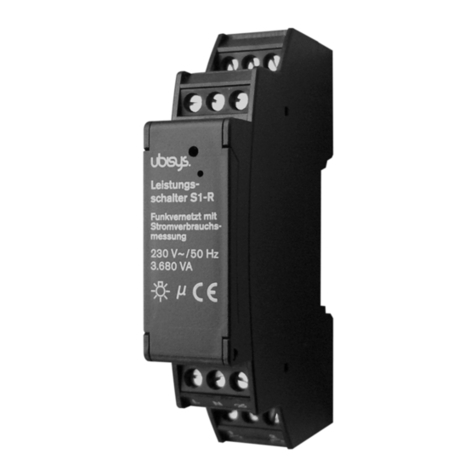
Ubisys
Ubisys Power Switch S1-R quick start guide
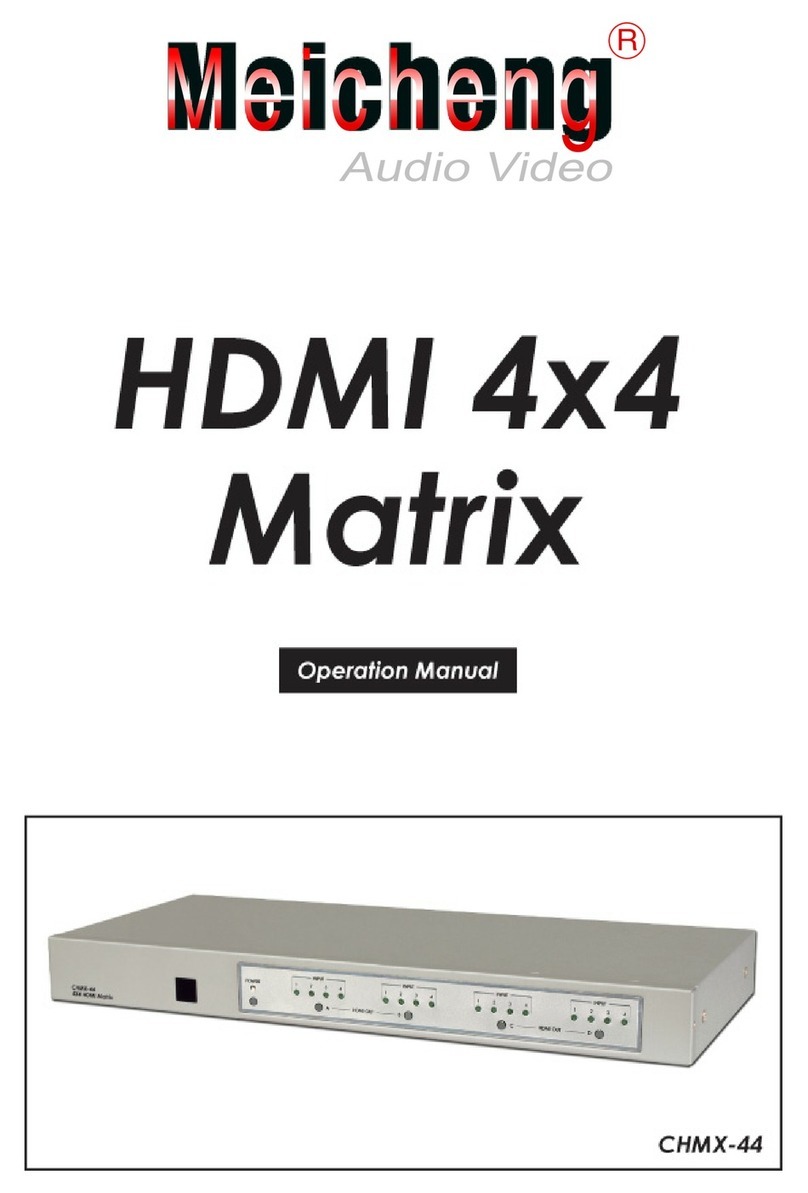
Meicheng
Meicheng CHMX-44 Operation manual

Maipu
Maipu MyPower S4100 Series Troubleshooting
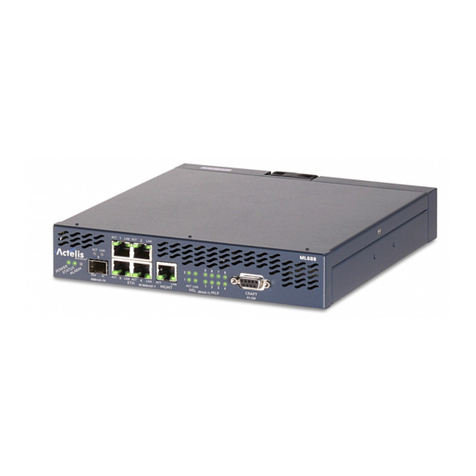
Actelis
Actelis ML600 Quick installation guide
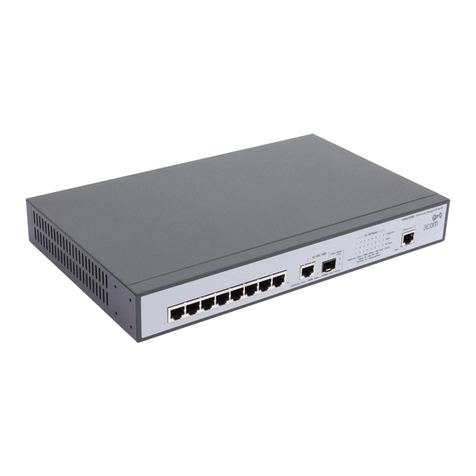
3Com
3Com 3CRDSF9PWR-US - OfficeConnect Managed Fast Ethernet PoE... user guide
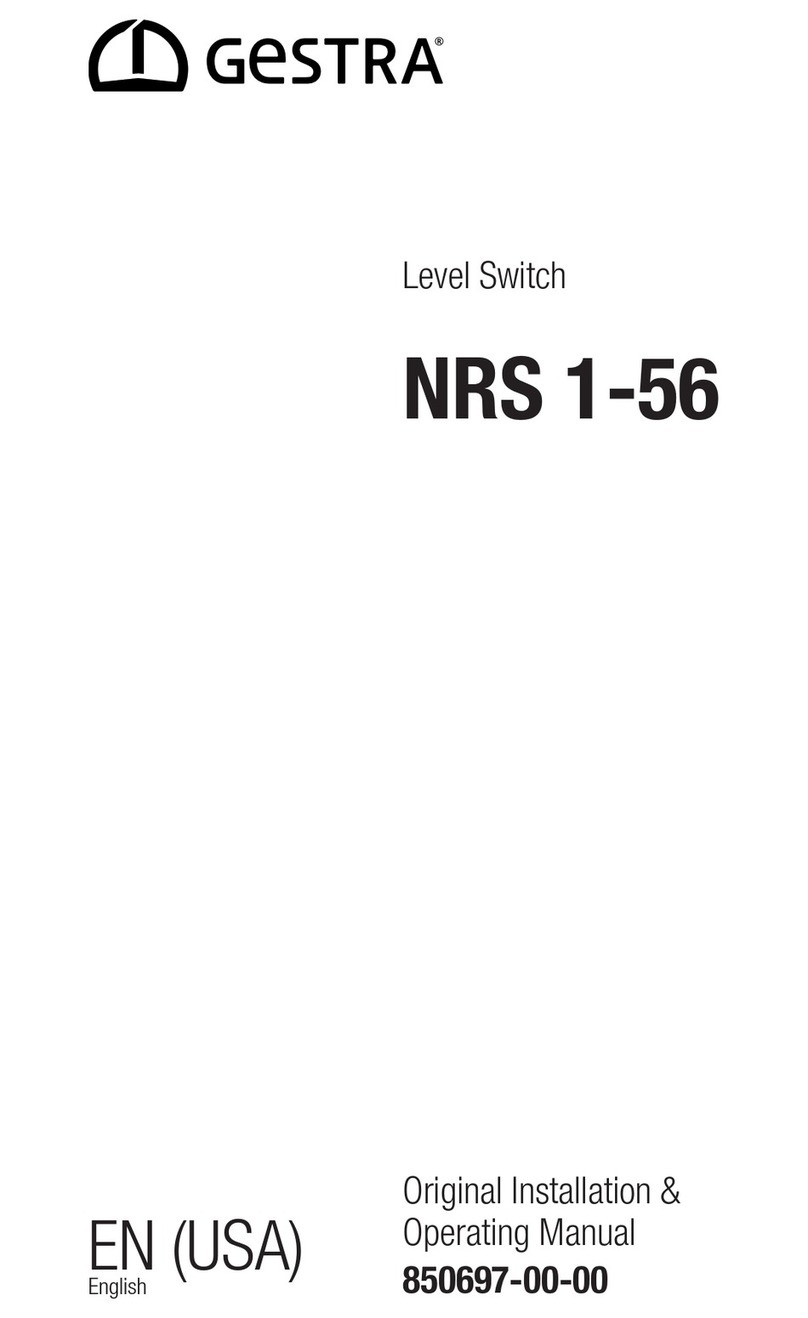
GESTRA
GESTRA NRS 1-56 Original Installation & Operating Manual
